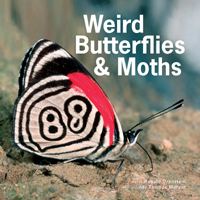| ________________
CM . . .
. Volume XXIV Number 3. . . .September 22, 2017

 |
Weird Butterflies & Moths.
Authoretc
Grades 5-7 / Ages 10-12.
Review by Gillian Richardson.
**** /4
|
| |
|

excerpt:
The Forest Giant Owl is a large butterfly from South America. The eyespots on its wings have a white “sparkle” in the center. This sparkle looks like the highlight in a real eye—perhaps the eye of an owl or a snake. And it may look even bigger to a hungry bird. This is because the sparkle reflects ultraviolet light. We can’t see ultraviolet light, but birds can, so to them the sparkle looks much bigger. Scientists found that birds were afraid of a model butterfly with eyespots. They were even more frightened if the eyespots had sparkles in them.
As the title suggests, Weird Butterflies and Moths is not a book about the usual or familiar butterflies and moths you might see in your garden. The super close-up photos highlight some of the oddities among the insect order, Lepidoptera, and the accompanying text details their behaviour, life cycles, and unique adaptations which help them avoid predation and allow survival in specific habitats. The first two-thirds of the book show butterflies and moths, and the last third focuses on caterpillars.
The Introduction is a single page that gives a summary of fascinating facts to whet your appetite. For instance, it explains that butterflies are a type of moth; of 200,000 moth species, about 17,500 are butterflies. It was amazing to learn that moths may have been around 230 million years. Physical characteristics are covered briefly, including differences between butterflies and moths. Some clues are given about how migration is achieved, as well as particular food and how it might contribute to predator avoidance. The author also touches on reasons for population decline, followed by suggestions for encouraging butterflies and moths to inhabit your garden. Websites offered will help both children and adults learn more about these insects.
The short text inserts are written in an inviting style with thoughtful choice of content to catch a reader’s interest. For instance, the “Comet Moth cocoons are full of holes. It is very rainy where they live, and the holes let water drain out so the pupa inside won’t drown.” Who would guess! The Index lists both common and Latin names.
Wonderfully clear photos show a variety of examples: the mass migration of Monarch butterflies and the similar mass roosting habits of African Tiger Moths, one tropical species with almost a foot-long wingspan, the world’s smallest butterfly at half an inch, those with huge eye spots on their wings, brilliant moths with a thick covering of hair, some so well camouflaged you’d mistake them for twigs, leaves or bird droppings—even moths that resemble bees and hummingbirds. Among the most curious are the ghostly White Plume Moth with feathery fringes on its wings, and the Darwin’s Moth with a foot-long tongue able to feed from an orchid with an equally long tube holding its nectar.
Caterpillars are just as captivating. Some grip branches with false legs, others make high-pitched chirps or give off poisonous chemicals to warn away their enemies. Many of the most brilliantly colored and attractive to look at are the ones most likely to inflict painful stings. One especially intriguing species is the Chinese Moon Moth caterpillar, a creature that mimics a cluster of pine needles to avoid detection. It goes through a growth cycle of several months, only to die in a few days once it becomes an adult moth.
If the Canadian author’s and Swiss photographer’s objectives were to amaze and arouse curiosity, they’ve succeeded with this compact and appealing book. The fact that the subject of their work is a part of the natural world both exotic and largely hidden from most of us only adds to the intrigue.
Highly Recommended.
Gillian Richardson is a freelance writer living in BC.

To comment
on this title or this review, send mail to cm@umanitoba.ca.
Copyright © the Manitoba Library Association. Reproduction for personal
use is permitted only if this copyright notice is maintained. Any
other reproduction is prohibited without permission.
Next Review | Table of Contents For This Issue - September 22, 2017
CM Home | Back Issues
| Search
| CM Archive
| Profiles Archive
|
